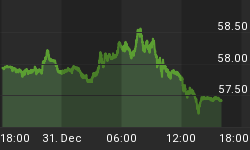A real yield of 0.82% for ten years isn't exactly plush, but on the other hand it is nearly double the real yield that prevailed on the day that the Fed announced QE2 (see Chart).

Real yields are abruptly climbing
Ironic, isn't it, that between August 27th, when Chairman Bernanke first talked openly about QE2, and November 3rd, when QE2 was effected, 10-year real yields declined from 1.01% to 0.41%. Subsequent to the actual announcement of QE2...when the Fed actually started adding money to the system...real yields rose back to 0.82%. I wrote on October 28th, rather presciently if I do say myself, a comment entitled "The Bang We Have Already; The Bucks Are Yet To Come." http://mikeashton.wordpress.com/2010/10/28/the-bang-we-have-already-the-bucks-are-yet-to-come/ My point was that the decline in real yields we had already seen was probably most of what we were likely to see even once the Fed actually followed through. I did not, however, suggest that we would see a sharp rebound higher in real yields and a decline in inflation expectations.
Obviously, this is a classic buy-the-rumor, sell-the-news outcome. Real yields of 0.4% for a decade didn't make any sense economically; yields were there because buyers expected that the combination of quantitative easing and the resulting Fed buying would make TIPS rally and make them relatively invulnerable to a selloff (the Fed is, after all, buying virtually all of the marginal TIPS supply through next summer). Ten-year real yields back to 1% wouldn't be terrific, but it would make this asset class at least competitive again with some of the other (expensive) asset classes available.
Inflation-linked bonds were not the only instruments struck by a selloff today, to be sure! The nominal 10y note rose to 2.95%, the highest yield since early August. Keep in mind, this was with Retail Sales data that was as-expected at +0.4% ex-auto, but an extremely severe miss from the Empire Manufacturing survey. That survey printed -11.14, the worst figure since early 2009, compared to expectations for +14.0. There were sharp declines in the subcomponents of New Orders (-24.38 vs. +12.90), Shipments (-6.13 vs +19.39), Number of Employees (+9.09 vs +21.67), and Average Workweek (-12.99 vs +3.33). The 25-point miss was the worst in at least 9 years (that's all the data that Bloomberg had), although there was a 22-point miss in 2005 so it isn't entirely unprecedented. The index is now at levels that are much more consistent with recession than with recovery (see Chart).

Empire Manufacturing. Maybe we're not out of the woods yet!
Empire Manufacturing is merely a single number, which ordinarily wouldn't raise eyebrows even with a modest miss. But a miss of this size does raise the possibility that something more serious is going on and raises the stakes for forthcoming economic releases.
It didn't, though, support fixed-income.
The bond selloff could perhaps be seen partly through the lens of re-risking, although that seems to me a stretch. It is true, though, that the only bond markets to rally in Europe were in Italy, Spain, Portugal, and Ireland. But a re-risking seems premature, to put it mildly, when to my eyes nothing about the looming catastrophe in Ireland (or for that matter Portugal) has changed. And the re-risking didn't extend to equities, which had a minor rally going but couldn't sustain it into the close.
Sometimes, the zigs and zags don't need to make sense. Sometimes, after all, they are just zigs and zags. Especially as we get further into November, and even more into December, the analyst needs to remember that sometimes markets move because liquidity is diminishing and some big account needed to get something done today.
In the bigger picture, though, I don't have any problem with the notion that real yields can rise appreciably further while nominal yields rise further still. It is hard to imagine how all of this can happen when the Fed is buying hundreds of billions of dollars' worth of bonds, but I am gifted/cursed with a creative imagination. Here's one way: if the foreign central banks - the ones who have expressed dismay at the Fed's explicit QE when they were being more discreet themselves in their own QE - decided to meet the Fed's bids with their own offers, then the Fed's buying would be easily overwhelmed. I don't really sit around worrying about that, because even if they did so those dollars either need to be recycled into US goods or recycled into US assets. It could pressure the dollar, but some dollar devaluation is what the Fed is seeking anyway.
The arrow of future inflation seems to point upwards. This indicates that higher yields are (eventually) in the offing. I just don't know that the recent selloff is the beginning of this process, or just some more zigs and zags.
Data tomorrow include PPI (Consensus: +0.8%, +0.1% ex-food-and-energy) and Industrial Production/Capacity Utilization (+0.3%/74.9%). The PPI isn't very useful as a gauge of inflation, but there is one somewhat interesting implication of PPI that I will discuss tomorrow. And Industrial Production doesn't usually draw much attention when Cap U is in the 70s. Given the Empire number today, though, a surprisingly weak IP/CU release may raise more eyebrows than did the Empire number alone.
















